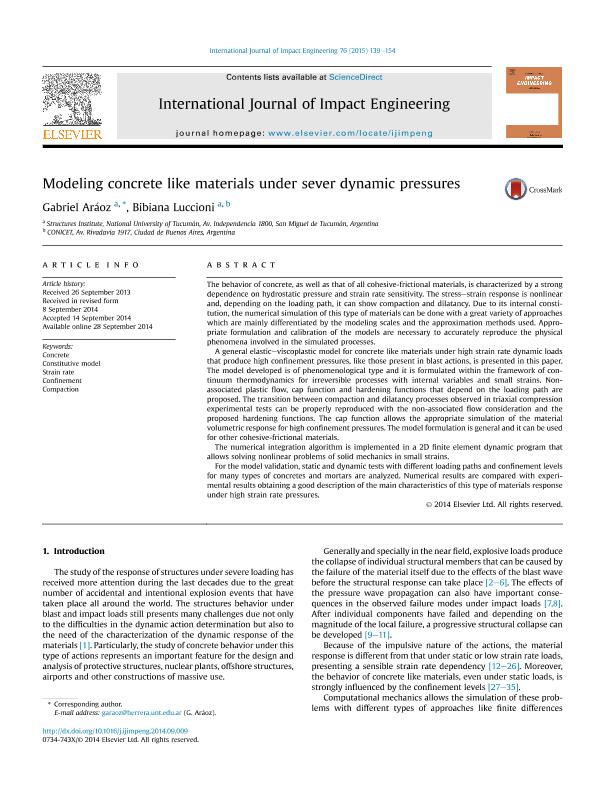Mostrar el registro sencillo del ítem
dc.contributor.author
Araoz, Gabriel Francisco

dc.contributor.author
Luccioni, Bibiana Maria

dc.date.available
2018-05-09T14:02:23Z
dc.date.issued
2015-02
dc.identifier.citation
Araoz, Gabriel Francisco; Luccioni, Bibiana Maria; Modeling concrete like materials under sever dynamic pressures; Pergamon-Elsevier Science Ltd; International Journal Of Impact Engineering; 76; 2-2015; 139-154
dc.identifier.issn
0734-743X
dc.identifier.uri
http://hdl.handle.net/11336/44569
dc.description.abstract
The behavior of concrete, as well as that of all cohesive-frictional materials, is characterized by a strong dependence on hydrostatic pressure and strain rate sensitivity. The stress–strain response is nonlinear and, depending on the loading path, it can show compaction and dilatancy. Due to its internal constitution, the numerical simulation of this type of materials can be done with a great variety of approaches which are mainly differentiated by the modeling scales and the approximation methods used. Appropriate formulation and calibration of the models are necessary to accurately reproduce the physical phenomena involved in the simulated processes. A general elastic–viscoplastic model for concrete like materials under high strain rate dynamic loads that produce high confinement pressures, like those present in blast actions, is presented in this paper. The model developed is of phenomenological type and it is formulated within the framework of continuum thermodynamics for irreversible processes with internal variables and small strains. Non-associated plastic flow, cap function and hardening functions that depend on the loading path are proposed. The transition between compaction and dilatancy processes observed in triaxial compression experimental tests can be properly reproduced with the non-associated flow consideration and the proposed hardening functions. The cap function allows the appropriate simulation of the material volumetric response for high confinement pressures. The model formulation is general and it can be used for other cohesive-frictional materials. The numerical integration algorithm is implemented in a 2D finite element dynamic program that allows solving nonlinear problems of solid mechanics in small strains. For the model validation, static and dynamic tests with different loading paths and confinement levels for many types of concretes and mortars are analyzed. Numerical results are compared with experimental results obtaining a good description of the main characteristics of this type of materials response under high strain rate pressures.
dc.format
application/pdf
dc.language.iso
eng
dc.publisher
Pergamon-Elsevier Science Ltd

dc.rights
info:eu-repo/semantics/openAccess
dc.rights.uri
https://creativecommons.org/licenses/by-nc-sa/2.5/ar/
dc.subject
Concrete
dc.subject
Constitutive Model
dc.subject
Strain Rate
dc.subject
Confinement
dc.subject
Compaction
dc.subject.classification
Ingeniería de los Materiales

dc.subject.classification
Ingeniería de los Materiales

dc.subject.classification
INGENIERÍAS Y TECNOLOGÍAS

dc.title
Modeling concrete like materials under sever dynamic pressures
dc.type
info:eu-repo/semantics/article
dc.type
info:ar-repo/semantics/artículo
dc.type
info:eu-repo/semantics/publishedVersion
dc.date.updated
2018-05-04T16:47:51Z
dc.journal.volume
76
dc.journal.pagination
139-154
dc.journal.pais
Estados Unidos

dc.journal.ciudad
New York
dc.description.fil
Fil: Araoz, Gabriel Francisco. Consejo Nacional de Investigaciones Científicas y Técnicas; Argentina. Universidad Nacional de Tucuman. Facultad de Ciencias Exactas y Tecnologia. Instituto de Estructuras ; Argentina
dc.description.fil
Fil: Luccioni, Bibiana Maria. Consejo Nacional de Investigaciones Científicas y Técnicas; Argentina. Universidad Nacional de Tucuman. Facultad de Ciencias Exactas y Tecnologia. Instituto de Estructuras ; Argentina
dc.journal.title
International Journal Of Impact Engineering

dc.relation.alternativeid
info:eu-repo/semantics/altIdentifier/doi/https://dx.doi.org/10.1016/j.ijimpeng.2014.09.009
dc.relation.alternativeid
info:eu-repo/semantics/altIdentifier/url/https://www.sciencedirect.com/science/article/pii/S0734743X14002280
Archivos asociados
